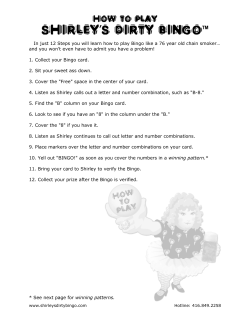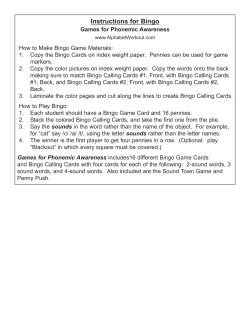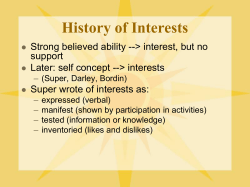
Tips for Using Picture Dictionaries Recommended supplies: colored stickies
Recommended supplies: colored stickies recipe cards notebook with lined paper blank handwriting paper markers pencils Tips for Using Picture Dictionaries Identify a page in the picture dictionary that seems relevant to your student's life. Identify 5 words you think your student would like to learn (see if s/he can point to the page/pictures that she is interested in learning about). Listening: Point to each picture and say the word associated with the picture. Repeat this several times with approximately 5 words (per lesson). Speaking: Have the student point to the picture when you say the word. Repeat this several times. Reading: Point to the word associated with the picture and then point to the picture. Point to the first letter of each word and say the letter. Repeat this several times for each of the 5 words. Ask your student to say the first letter as you point to each word/picture. Write the words on a piece of paper & see if your student can read the words and/or point to the picture associated with the words. Writing: Write the words on lined paper. Have your student copy the words & then write them a few times. Create simple activities: Created by Refugee Transitions and Dion Zizak FOR ALL STUDENTS: 1. Matching: Draw the pictures on left side of a piece of paper (have your student help with this) Write the words on the ride side of a piece of paper (in different order) Have your student draw a line to match the picture and drawing. 2. Create flashcards. Use index cards or cut up pieces of blank white paper. Write a vocabulary word on one side of each card. On the other side, draw a picture of the person, place or thing. Have your student help with this. Use these to help your student practice saying the word when seeing the picture and also when seeing the word. 3. Create a concentration/memory game. Make 5 pairs of one-sided flash cards: one card should have a word with no picture, and the other card should have a picture with no words. Make a pair for each vocabulary word (using five words). Turn all the cards face down on a table and then choose two cards. The goal of the game is to try to find two that match: a word with a picture. If they do not match, say the word, (e.g., “bread – bread”). If they do not match, say the word for each card anyway for practice, (e.g., “bread – milk”). 4. Create a listening game. Put the cards all down on the table picture side up. Say a word and have your student choose and pick up the card that you have named. Try this again with the written word side showing (no pictures this time). 5. Create a letter scramble. Choose one of the five words (choose a word with five or less letters). Write each of the letters on a separate index card or piece of blank paper. Show the student how the letters are arranged in order. Say the word and reinforce the meaning by pointing to the picture. Scramble the letter cards and model how to put them back in order. Scramble them again and see if your student can arrange the letters, with or without looking at a model of how the word is spelled. A little more: Have your student do this with several words, one at a time, and glue the letters down onto a sheet of colored paper when they are finished to make a review sheet. For more advanced students: Spread out the letters for 3-5 words at once. Have your student spell the words using the letter cards. 6. Work on writing the first letter. Write the first letter of the word large on large lined paper. Model how to write the letter several times. Have your student practice writing the letter many times on the page. Circle the best one. 7. Same or different? Working with letters. Write a row of copies of the first letter. Make the first one correct but include several errors in the next ones. Sometimes write the letter upside down, backwards, or with missing pieces. See if your student can circle the letter only when it appears correctly, matching with the first. *Note: Reinforce the words “same” and “different” by repeating them slowly and clearly many times throughout the game, pausing before and after the word. These words will be useful for many teaching activities. 8. Same or different? Working with words. Write the word correctly once. Next to or Created by Refugee Transitions and Dion Zizak underneath, write the word three more times, 2 correct and one incorrect. See if your student can pick out which one doesn’t match the first. 9. Capital and Lower Case: starting with a letter that the student already knows. write the capital letter above the lower case one. Start with the letter as the student already knows it (ie., capital R). Say “R” pointing to the capital R and Say “r” pointing to the lower case. Have students practice writing the capital and lower case letters and saying the name of the letter. A little more: Do this with three familiar letters, and then put the letters on separate cards and create a matching game. 10. Create a missing letters game. Write the word. Underneath, write the word with a few missing letters with spots for the student to fill in what is missing. A little more: Create a tree, a monster, or any drawing you like. Using the format of the old “hangman” game, create a nonviolent drawing as your student guesses letters to complete a word you have practiced together. 11. Create a Bingo game: Easily create a Bingo game with words using this website: http://www.eslactivities.com/bingo.php 12. Use other materials. Bring string, beads, play-dough, or sparkles and glue with you to your lesson. Have your student create either the entire word or just the first letter using any of these types of materials. 13. Find household materials. See if you can have your student help you find materials in their home which match the vocabulary words or the topic. Some examples may include food, clothing, or drugstore items such as band-aides, cough drops, or shampoo. Once the items are collected, they can be used to practice naming items in the same way pictures were used. 14. Do role plays. Some vocabulary words can be acted out, such as feeling words (happy, sad, angry, surprised), health and wellness words (headache, backache, sore throat), activities (see daily activities and sports). Act out the word and say the word out loud at the same time, then see if your student can say the word from just watching your actions. Switch roles and have your student can role play the activity while you guess the word. A little more: Create a two or three line dialogue to go with the activity: Example: Health unit. What’s wrong? I have a headache (holds head) Feel better! For more advanced students: Create a more complex dialogue, (3 or 4 lines for each speaker). Write it out and practice together. Then make some small changes to show possible variation in the conversation. 15. Likes and dislikes. Tell which items you like and don’t like (works great with food). Ask your student what he/she likes. Have your student practice the sentence “I like ___.” A little more: Ask “Which is your favorite__?” This can be applied to many topics. For more advanced students: Ask them to tell you why they like or don’t like certain things. Have students write about their likes and dislikes. Created by Refugee Transitions and Dion Zizak 16. Tell a story. Use the pictures in the picture dictionary to tell a story. Have your student listen and point to certain items in the pictures. A little more: Have your student help tell the story by stopping periodically and having them fill in your blanks with a missing word. Point to pictures to demonstrate which word is needed. For more advanced students: Have your student tell you a story about the picture. Have them write a story about the picture. 17. Self-descriptions. Using the family pages, have students tell you about themselves. Example: I am a mother. I am a grandmother. A little more: Add more vocabulary that can be used for self-descriptions. Have students write one or two simple sentences describing themselves. For more advanced students: Have students describe several things about themselves, and write a short biography. Make a small poster or booklet that shows the student (either a selfportrait or photo) with a short auto-biography. 18. Create a Journal Entry. Have your student list things that she or he did that day, or foods she or he ate. Write down the key words the student says and read them together. A little more: Have your student write their own journal entry, listing key words about their day. For advanced students: Include more vocabulary and more topics in the journal. Include events at home or school and feelings or reactions. 19. Write a card or letter. Students can make a card with a short message such as I love you, happy birthday, or thank you. (see birthdays p.240) A little more: Have your student add a short message to the card. For more advanced students: Have your student write a letter to a family member using some of the topic words. This can work especially well with feeling words, food, and family words (asking or telling about family members). 20. Comparisons. Items such as food, household/drugstore items, and clothing can be compared with similar items in your student’s home country. Ask if these things are the same or different in their home country. Have them describe the differences. For more advanced students: Have your student write about an item that is different in their home country. Created by Refugee Transitions and Dion Zizak
© Copyright 2025





















